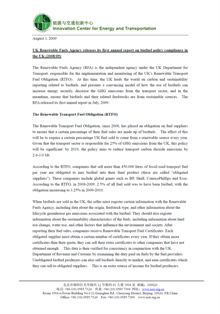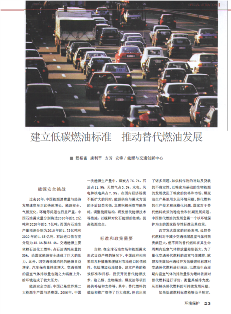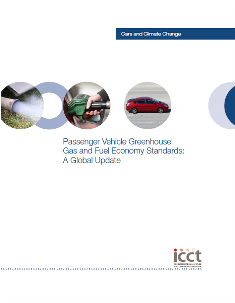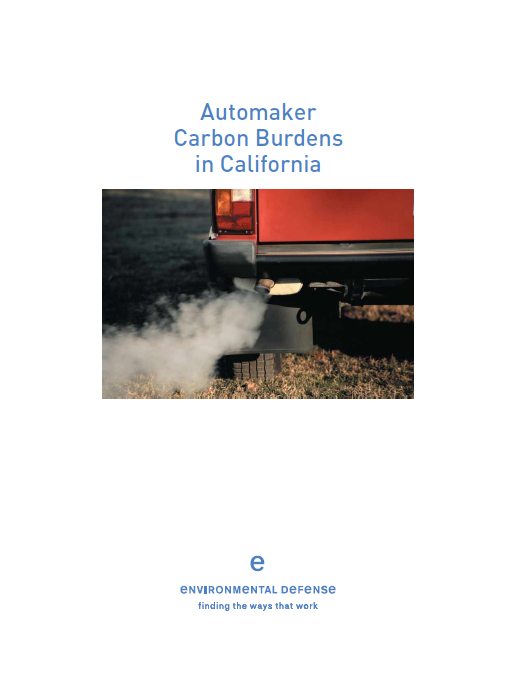Research Reports

Review on 2008/09 UK-RTFO Implementation Annual Reports and Suggestions on China Low Carbon Fuels Development (May 2009 / Clean Transportation Program)
This paper is to make a review on 2008/09 UK-RTFO implementation annual reports and suggestions on china low carbon fuels development.

Background Report for China Low Carbon Fuel Standards and Policies (February 2009 / Clean Transportation Program)
Currently, global energy consumption is growing fast due to the rapid economy development of developing countries. Energy security and climate change issues have already become two most significant barriers to hurdle the sustainable development globally. The energy and environment problems are particularly severe in China. Therefore, strong and effective government policies are crucial to enhance the energy security and the sustainable development. This report mainly discusses china transportation situation, alternative transportation energy, green house gas emission of transportation energy, fuel life cycle green house gas evaluation, and China low carbon policy promotion, etc.

Building Low Carbon Fuel Standards, Promoting Alternative Development (May 2008 / Clean Transportation Program)
This article briefly introduces challenges of energy security that China is facing, requirements for energy standards and policies, projects of China low carbon fuel standards and policies, as well as implementations for those standards and policies.

Passenger Vehicle Greenhouse Gas and Fuel Economy Standards: A Global Update (July,2007 / Clean Transportation Program)
Governments around the world are currently grappling with two distinct but interconnected issues – how to reduce emissions of climate changing greenhouse gases (GHG) and how to reduce dependence on finite and often improved supplies of petroleum. This report compares on an equal basis the vehicle standards that have recently been put in place, updated or proposed by governments around the world to address these two policy goals.

Climate Change Mitigation Strategies for the Transportation Sector in China(July,2006 / Clean Transportation Program)
The Chinese transportation sector is becoming an increasingly crucial factor affecting global climate change. This paper has been written in order to give foreign observers a clearer understanding of the scope of the challenges in China, and to put forward a framework for discussions on climate change mitigation strategies in the transportation sector.

Automakers' Corporate Carbon Burdens (August, 2005)
The report highlights new vehicle CO2 emissions by automaker for the period 1990–2003. It also reviews the historical trend of total U.S. light vehicle carbon emissions, analyzing the on-road stock of all vehicles, both new and used, during the period 1970–2003. Based on the analysis, the conclusion on how to improve the reduction of emissions is presented.

Comparison of Passenger Vehicle Fuel Economy and GHG Emission Standards around The World (Dec.2004 / Clean Transportation Program)
Nine major regions around the world have implemented or proposed various fuel economy and greenhouse gas (GHG) emission standards. Yet these standards are not easily comparable, due to differences in policy approaches, test drive cycles, and units of measurement. This paper develops a methodology to compare these programs to better understand their relative stringency

Automotive CO2 Emissions Characterization by U.S. Light-Duty Vehicle Platform (November,2004 / Clean Transportation Program)
Raising the fuel economy of automobiles to lower carbon dioxide (CO2) emissions affects many aspects of vehicle design. Automakers organize their production using platforms, representing shared engineering across different models. A platform level of aggregation is therefore useful when examining the opportunities for and impacts of redesign. This paper explores the CO2 emissions-related characteristics of major platforms in the U.S. market, using data for model year 2002.

Automaker Carbon Burdens in California(October,2004 / Clean Transportation Program)
The carbon burden imposed by an automaker’s sales is calculated as the product of sales volume, the fleet average CO2 emission rate of the vehicles sold, and the expected annual miles of driving over the life of the vehicles. By assembling the best available data from state, federal, and automotive trade sources, this report characterizes the carbon burdens of the California car market in model year 2002.